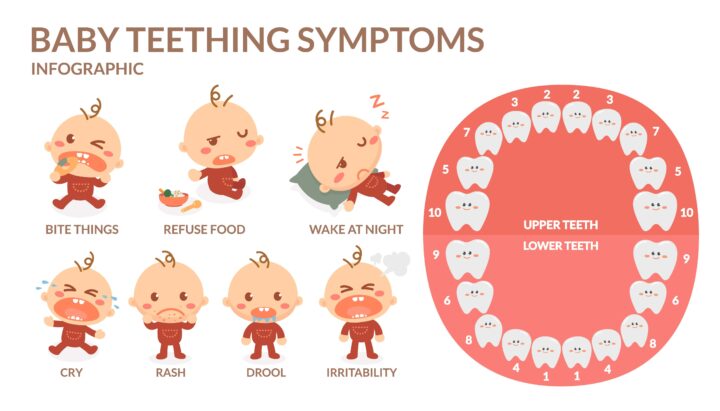
z
Teething is one of those phases that parents face when they have a newborn in the house. Although every baby is special, a common question that most parents ask eventually comes up: How long does teething last? Anyway, this will help you answer that question and at least give some insights so maybe the journey would be a bit less hard sometimes.
Understanding the Teething Process
What is Teething Informally when baby teeth begin to erupt through the gum. This typically starts between four and seven months, but can be earlier or later. Most often, the bottom front teeth arrive first (the central incisors), and then they are followed by the top ones.
The process is different for every baby. Some infants sail through teething with barely a fuss, while others may experience discomfort, irritability, and disrupted sleep. So, let’s break down the teething timeline.
Teething Timeline: When Does It Start and End?
- 4-7 Months: Teething usually starts at this stage. Normally, it will be the two front food teeth (central incisors) emerging first.
- 8 to 12 Months: The upper front teeth (central incisors) usually arrive next. Your baby may have by this time four teeth.
- 9 to 16 Months: These two little teeth, known as the top and bottom lateral incisors (next along from these front teeth), bring each row up to six.
- First Molars (Back Teeth): Normally appear between 13 and 19 months, these teeth are in the back of the mouth on both top & bottom.
- 16 and 23 months: The upper canine teeth next to the lateral incisors emerge both on top and bottom
- 23 to 33 Months: The second molars come in last. These teeth, located in the very back, are often the most painful and challenging for babies to handle.
How Long Does Teething Last?
The entire teething process takes an average of 6 months to about two and three years. The more large molars can take about 3 to 4 day to fully erupt individually, causing symptoms early on and are usually few days behind before the whole tooth comes through.
Common Symptoms of Teething

Teething symptoms for baby can be more far-reaching. There are a few almost universal ones such as:
- Drooling more than usual
- Irritability and fussiness
- Red or swollen gums
- Swallowing objects or things being chewed on more.
- Trouble sleeping
- Decreased appetite
Remember that while mild symptoms are usual, a high fever or severe diarrhea would not be considered typical teething signs. Do consult a pediatricians if your baby has any of these symptoms.
How to Soothe a Teething Baby

Teething can be a painful process for babies, but there are also many ways to ease the discomfort associated with it.
- Chewable Toys: Chilled (not frozen) teething rings or soft chewable toys can help massage the gums.
- A cool washcloth: A cold, wet cloth for baby to chew on can help decrease inflammation and relieve pain.
- Soft Gum Massage : you can use a clean finger to gently massage your baby’s gums.
- Pain Relievers: If your baby is particularly uncomfortable, ask your pediatrician if an over-the-counter pain reliever like infant acetaminophen is appropriate.
When to See a Doctor
Although teething is a very common part of child development, there are times when you should call the doctor. If your baby has wanted to eat less, or is more cranky than usual and showing signs of infection: redness in the gum next to where a tooth is coming out may become swollen (tumor) have pus clinically manifesting Febrile state You also consult with pedia.writerow.
Concluding Thoughts: Each Baby is Uniquely Themselves
So, how long will this teething saga persist? Though it may seem never-ending, the discomfort typically subsides after a few days or up to a couple of weeks for each tooth. However, the full journey of teething can stretch across 2 to 3 years. Most toddlers will sport their complete set of pearly whites by the time they hit the 18-month to 3-year mark.
It’s crucial to keep in mind that no two babies are alike. What brings relief to one child might not work for another—and that’s perfectly fine. Stay patient, try out various soothing techniques, and rest assured—this phase will pass, and both you and your little one will come out stronger on the other side.
Common Questions
1. How many teeth will my child eventually have?
By the time your child reaches 3 years of age, they will likely have a complete set of 20 baby teeth.
2. What’s the most effective way to ease teething discomfort?
Cold compresses, teething rings, and gentle gum massages can offer much-needed relief. Consulting your pediatrician about infant-safe pain relievers might also be helpful if the discomfort becomes intense.
3. Is diarrhea a symptom of teething?
Teething doesn’t directly cause diarrhea, but some babies swallow excess saliva, which can upset their stomach, leading to looser stools.
4. Can I continue breastfeeding my baby during teething?
Absolutely! Breastfeeding can offer comfort to teething babies. Just be cautious of any nibbling, and if biting occurs, gently break the latch and try again.
5. What if my baby hasn’t cut any teeth by their first birthday?
If your baby hasn’t sprouted any teeth by 12 months, there’s no need to worry. Some little ones take their time. However, it’s always good to check in with your pediatrician to ensure everything is progressing normally.

